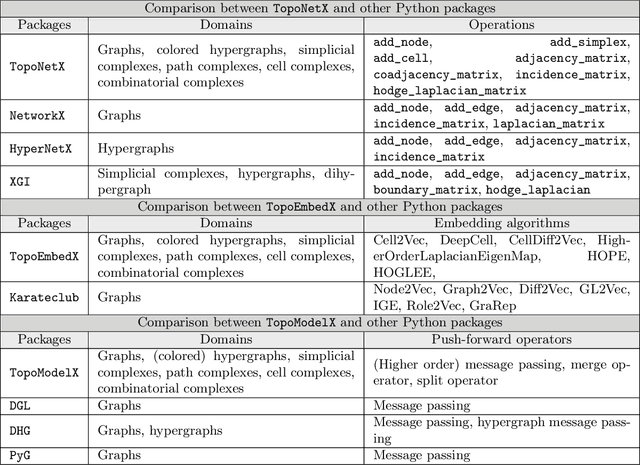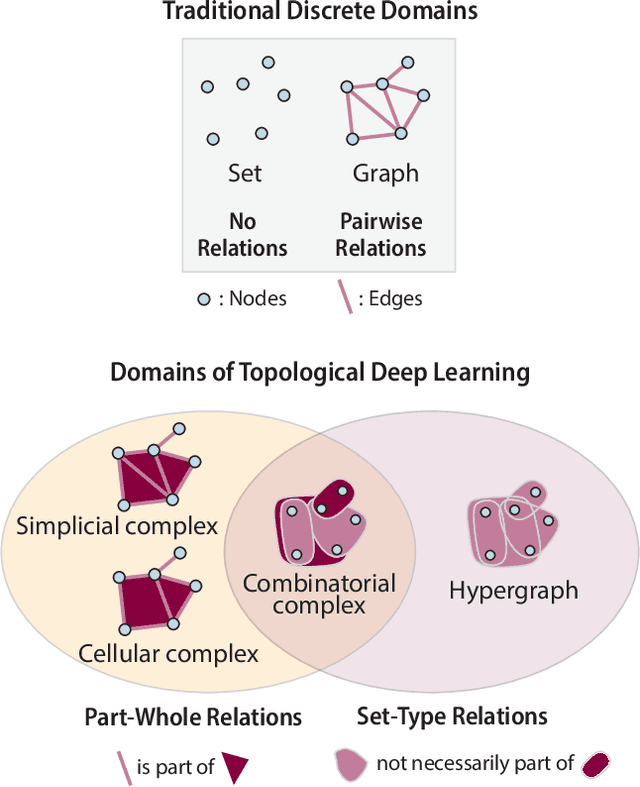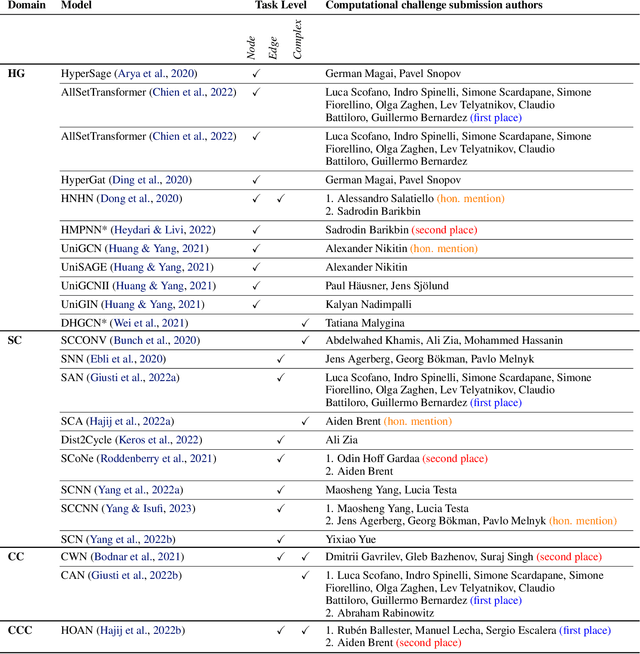Aldo Guzmán-Sáenz
TopoX: A Suite of Python Packages for Machine Learning on Topological Domains
Feb 07, 2024

Abstract:We introduce topox, a Python software suite that provides reliable and user-friendly building blocks for computing and machine learning on topological domains that extend graphs: hypergraphs, simplicial, cellular, path and combinatorial complexes. topox consists of three packages: toponetx facilitates constructing and computing on these domains, including working with nodes, edges and higher-order cells; topoembedx provides methods to embed topological domains into vector spaces, akin to popular graph-based embedding algorithms such as node2vec; topomodelx is built on top of PyTorch and offers a comprehensive toolbox of higher-order message passing functions for neural networks on topological domains. The extensively documented and unit-tested source code of topox is available under MIT license at https://github.com/pyt-team.
Topo-MLP : A Simplicial Network Without Message Passing
Dec 19, 2023Abstract:Due to their ability to model meaningful higher order relations among a set of entities, higher order network models have emerged recently as a powerful alternative for graph-based network models which are only capable of modeling binary relationships. Message passing paradigm is still dominantly used to learn representations even for higher order network models. While powerful, message passing can have disadvantages during inference, particularly when the higher order connectivity information is missing or corrupted. To overcome such limitations, we propose Topo-MLP, a purely MLP-based simplicial neural network algorithm to learn the representation of elements in a simplicial complex without explicitly relying on message passing. Our framework utilizes a novel Higher Order Neighborhood Contrastive (HONC) loss which implicitly incorporates the simplicial structure into representation learning. Our proposed model's simplicity makes it faster during inference. Moreover, we show that our model is robust when faced with missing or corrupted connectivity structure.
Combinatorial Complexes: Bridging the Gap Between Cell Complexes and Hypergraphs
Dec 15, 2023

Abstract:Graph-based signal processing techniques have become essential for handling data in non-Euclidean spaces. However, there is a growing awareness that these graph models might need to be expanded into `higher-order' domains to effectively represent the complex relations found in high-dimensional data. Such higher-order domains are typically modeled either as hypergraphs, or as simplicial, cubical or other cell complexes. In this context, cell complexes are often seen as a subclass of hypergraphs with additional algebraic structure that can be exploited, e.g., to develop a spectral theory. In this article, we promote an alternative perspective. We argue that hypergraphs and cell complexes emphasize \emph{different} types of relations, which may have different utility depending on the application context. Whereas hypergraphs are effective in modeling set-type, multi-body relations between entities, cell complexes provide an effective means to model hierarchical, interior-to-boundary type relations. We discuss the relative advantages of these two choices and elaborate on the previously introduced concept of a combinatorial complex that enables co-existing set-type and hierarchical relations. Finally, we provide a brief numerical experiment to demonstrate that this modelling flexibility can be advantageous in learning tasks.
ICML 2023 Topological Deep Learning Challenge : Design and Results
Oct 02, 2023

Abstract:This paper presents the computational challenge on topological deep learning that was hosted within the ICML 2023 Workshop on Topology and Geometry in Machine Learning. The competition asked participants to provide open-source implementations of topological neural networks from the literature by contributing to the python packages TopoNetX (data processing) and TopoModelX (deep learning). The challenge attracted twenty-eight qualifying submissions in its two-month duration. This paper describes the design of the challenge and summarizes its main findings.
Higher-Order Attention Networks
Jun 01, 2022



Abstract:This paper introduces higher-order attention networks (HOANs), a novel class of attention-based neural networks defined on a generalized higher-order domain called a combinatorial complex (CC). Similar to hypergraphs, CCs admit arbitrary set-like relations between a collection of abstract entities. Simultaneously, CCs permit the construction of hierarchical higher-order relations analogous to those supported by cell complexes. Thus, CCs effectively generalize both hypergraphs and cell complexes and combine their desirable characteristics. By exploiting the rich combinatorial nature of CCs, HOANs define a new class of message-passing attention-based networks that unifies higher-order neural networks. Our evaluation on tasks related to mesh shape analysis and graph learning demonstrates that HOANs attain competitive, and in some examples superior, predictive performance in comparison to state-of-the-art neural networks.
 Add to Chrome
Add to Chrome Add to Firefox
Add to Firefox Add to Edge
Add to Edge